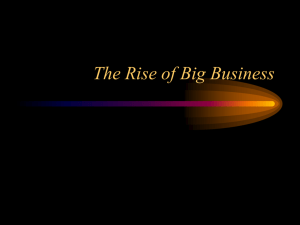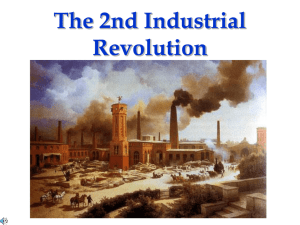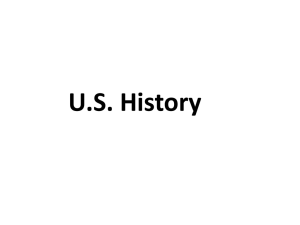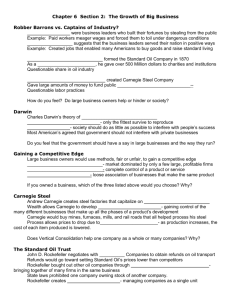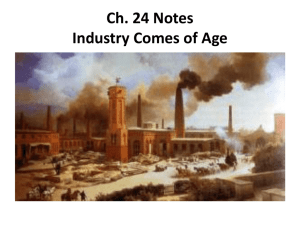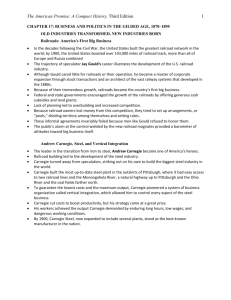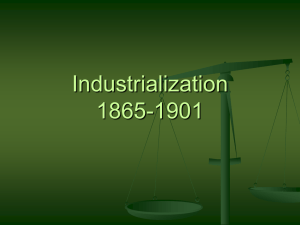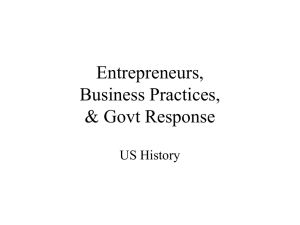Industrial Revolution
advertisement
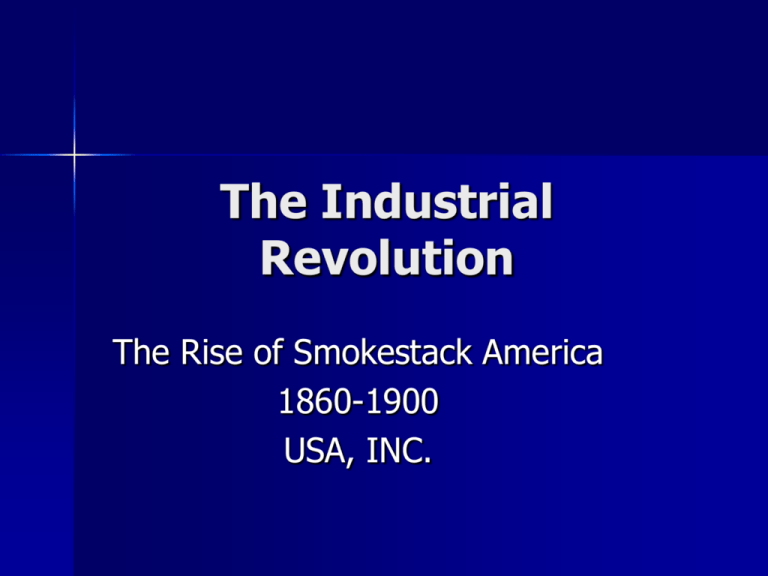
The Industrial Revolution The Rise of Smokestack America 1860-1900 USA, INC. Post-war industrial expansion Factors contributing to rise of American industry – – – – – Growth of a National Railway System Abundant natural resources Cheap, plentiful, docile labor force Technological Innovations Favorable Government Policies (laissez-faire) – Managerial Revolution “Robber Barons” or “Captains of Industry”? Railroad Tycoons: Jay Gould, Daniel Drew, Tom Scott, Cornelius and William Vanderbilt Industrial Monopolists: John D. Rockefeller, Andrew Carnegie, Gustavus Swift, James B. Duke Finance Capitalist: J. Pierpoint Morgan New Business Organizations Company-Privately owned by Individual, Family, Partners Corporation-Publicly owned by stock holders; run by elected Board Trust-Numerous Corporations’ stocks controlled by a Board of Trustees Holding Company-Numerous trusts’ stocks controlled by a Board of Directors Thomas Alva Edison “Wizard of Menlo Park” The Light Bulb The Phonograph (1877) The Ediphone or Dictaphone The Motion Picture Camera Alternating Current Nikola Tesla George Westinghouse Alternating Current Westinghouse Lamp ad Alexander Graham Bell Telephone (1876) The Airplane Wilbur Wright Orville Wright Kitty Hawk, NC – December 7, 1903 Model T Automobile Henry Ford I want to pay my workers so that they can afford my product! [$5 a day!] “Model T” Prices & Sales U. S. Patents Granted 1790s 276 patents issued. 1990s 1,119,220 patents issued. Impact of the RR on the Nation New Trans-continental Lines emerge Railroads as business National Market Impact on – – – – – – – – National unity & economics Industrialization Mining & agriculture Grown of cities & urban areas Immigration Environment Time Zones Wealth Corruption in the Railroad Industry Scams in the RR industry – – – – – Stock watering Bribery The “pool” Rebates & kickbacks Price gouging Government regulation of RR’s – State regulations and Supreme Court – Federal regulation (ICC) Jay Gould & Daniel Drew Tom Scott Rockefeller & Standard Oil Company Development of the American Oil Refinery Industry – 1st well – Kerosene – Gasoline John D. Wreck-afeller Efforts to curb competition, curb costs, set prices Horizontal integration – John D. Rockefeller in oil industry – Control more & more of a given niche (one stage of production) of an industry Steel Industry Factors contributing to growth of steel – Bessemer Process – Access to coal & iron ore – Ready labor Andrew Carnegie Vertical Integration – Controls up & down the hierarchy – Andrew Carnegie in steel industry Owned ore & coal mines, Railroads and barges, Processing Plants, Made Finished Iron & Steel products Mesabi Range Carnegie Homestead Steel Plant Henry Clay Frick : “Coke King” Carnegie and Labor Low Wages Long Hours Dangerous Working Conditions Anti-Union Strike Breaker (Homestead, 1892) Pinkertons & Scabs U. S. Corporate Mergers Wealth Concentration Held by Top 1% of Households % of Billionaires in 1900 % of Billionaires in 1918 New Financial Businessman The Broker: J. Pierpont Morgan Combination Consolidation Concentration J. Pierpoint Morgan Finance Capitalist U.S. Steel: 1st Corporation Capitalized at over $1 Billion J.P. Morgan and Company (Holding Company) A “Trust of Trusts”) Banking Insurance Steam Shipping Railroads (UP, SP, NP, Penn, B&O, C&O, L&N, AT&SF, Erie, Atlantic Coast, Reading, & many more) Communications (AT&T, Western Union) Public Utilities (Edison, NY, NJ, Chicago) Real Estate U.S. Steel Amalgamated Copper General Electric Westinghouse International Harvester National Biscuit Co American Sugar trust Pullman Company Armour & Company U.S. Rubber Co. American Ag. Chemical Pro-Business Government Policies Land Grants to Railroads Protective Tariff (1862- 1913) No Income or Corporate Taxes Laissez-Faire ? (Little or no regulation?) Wall Street – 1867 & 1900 Government & Industry Constitutional safeguards for industry – Interstate commerce clause – 14th Amendment Government attempts to control business – Sherman Anti-Trust Act – Enforcing the Sherman Anti0Trust Act – Significance of Act The Protectors of Our Industries The ‘Bosses’ of the Senate The ‘Robber Barons’ of the Past Justifications of Divisions between Rich & Poor Rising upper class Falling working class Defending class distinctions – Gospel of Wealth – Social Darwinism – Rugged individualism & contempt for poor – Popular aspirations: “self made man” Carnegie’s Philanthropy The Gospel of Wealth God-given “Stewardship” “Wise Benevolence” Carnegie’s Philanthropies Over $350,000,000 Music Halls Carnegie Institute Carnegie-Mellon University Endowment for International Peace 1679 Libraries 1679 Carnegie Libraries Social Darwinism British economist. Advocate of laissez-faire. Adapted Darwin’s ideas from the “Origin of Species” to humans. Herbert Spencer Notion of “Survival of the Fittest.” Social Darwinism in America $ $ William Graham Sumner Folkways (1906) Individuals must have absolute freedom to struggle, succeed or fail. Therefore, state intervention to reward society and the economy is futile! Horatio Alger Novels “Luck and Pluck” “Rags to Riches” “The American Dream?” Protestant (Puritan) “Work Ethic” Horatio Alger [100+ novels] Is the idea of the “self-made man” a MYTH?? Fiction? Edward Bellamy’s “Looking Backward” (1887) Henry George and the Single Tax Movement The Reorganization of Work Frederick W. Taylor The Principles of Scientific Management (1911) The Reorganization of Work The Assembly Line Unskilled Labor The Labor Movement Life of Workers Corporate resistance to unions – Use wealth to undermine – Appeal to federal courts – Used troops to break strikes – “lockouts” – “yellow dog contracts” & “ironclad oaths” – “blacklists” – Company towns Rise of Unions Early unions – National Labor Union (1866) – The Knights of Labor (1869) – The American Federation of Labor (1886) Strikes Popularity – Grow in strength but 3% of workforce in 1900 – Collective labor=“Radicalism” National Labor Union 8 hr. Day William Sylvis (1866-1873) The Great RR Strike of 1877 Pray for the dead and fight like hell for the living. I asked a man in prison once how he happened to be there and he said he had stolen a pair of shoes. I told him if he had stolen a railroad he would be a United States Senator. Cincinnati Railroad Station Strikers vs. Troops Who Wins? (1877) Molly Maguires Pennsylvania Coal Miners Damn Pinks- James McParland Knights of Labor One Big Union NO Strikes Terrence V. Powderly 700,000 members 1873-1886(?) McCormick Chicago Factory Strike Haymarket Incident-1886 Jolly Coppers and Anarchist Bombers? Anarchist Bastards John Peter Altgeld’s Pardon Emma GoldmanRussian Immigrant Red Emma-Anarchist Emma and Alexander Berkman Henry Clay Frick and Andrew Carnegie George Pullman’s Dream Pullman Palace Car Factory Worker’s Apartments Pullman’s Home Pullman Strike and Boycott Eugene V. Debs and the American Railway Union 5X Presidential Candidate until 1920 Samuel Gompers: AFof L Leader 1886-1924 P.J. McGuire Pure and Simple Unionism= “MORE!” Samuel Gompers’ Credo We want more school houses and less jails; more books and less arsenals; more learning and less vice; more constant work and less crime; more leisure and less greed; more justice and less revenge; in fact, more of the opportunities to cultivate our better natures, to make manhood more noble, womanhood more beautiful and childhood more happy and bright. These in brief are the primary demands made by the Trade Unions in the name of labor. These are the demands made by labor upon modern society and in their consideration is involved the fate of civilization. Sam in San Antonio
